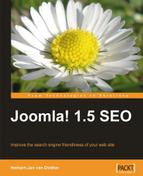You have looked at your title and altered it to get better results, and also looked at the content to make sure you are not overdoing the placement of your keywords. Now it's time to look at the rest of your article. If you look at the web page, you have to keep in mind the following thing:
Web site visitors don't read, they scan!
This means that your page has to grab their attention right away as you only have a few seconds to keep them on your web page. You need to give them an overview of the subject of the page by leading them in and encouraging them to look over the content of that page.
Don't believe me? We will look at some statistics later on that will make it clear to you that this is really the case.
Filling your web page with large blocks of text will scare your visitors away. Here is an example, on how to improve a web page and make it more scanable. As you can see there is a lot of text and no real visual outstanding items that show what the page is about except for the page title.

Not using white space between paragraphs is also a great way of telling people not to read your article. It makes the content difficult to read as you don't see the end of one paragraph and the beginning of the next one. In normal books, it has its place if you need to explain a difficult subject that needs a lot of text to prove a point and show how things are done.
For web pages, however, it is the best way of losing your visitors. Such pages scare people away from your site, as they don't know if the page is worth the time they will spend reading the content.
As I said earlier, your visitors are scanners. They scan your page looking for resting points, headers, and structures. These page elements tell them that they have found the right page, to get the information they are looking for. In the previous example you see that white space was used to create text blocks that are not too lengthy to read. The use of introduction lines for each block is also well done for page scanning.
Using headers and paragraph layouts is one way to provide the specific information needed by scanners so that they start reading the article.
If you write a lengthy page about a certain topic, you can always split it into different paragraphs. If you do that, you will also have a clear idea of which paragraphs can be grouped together. Those paragraphs will have one keyword in common. Use that keyword to break the page.
A page on Japanese Garden design elements could be very long. You can easily break it into page sections. For instance, with headers such as "Garden design structures" and "Japanese Garden elements."
These headers should not be given a Heading level one tag, but one below that, such as Heading level two. If you don't want to use the HTML codes, or you don't know how to, just make them bold and use a bigger font to make them stand out.
If you have images on your page, place them near those breaks. If you still have a lengthy text section, place a smaller image in the middle of that text to break it into two pieces.
For a very long page, make a table of contents in the first paragraph and create placeholders for easy navigation. Placeholders are links to various sections on the same page so that you can jump to that location just by clicking on the placeholder link. To learn more about how to create such placeholders you can check the example on http://www.w3schools.com/HTML/tryit.asp?filename=tryhtml_link_locations.
The use of keyword-rich hyperlinks to the subjects placed in the table of content is also good for your Search Engine Optimization as you create extra keyword-rich links inside that page. Using bullet points, if useful, is also a good way to break your page and invite people to read on.
